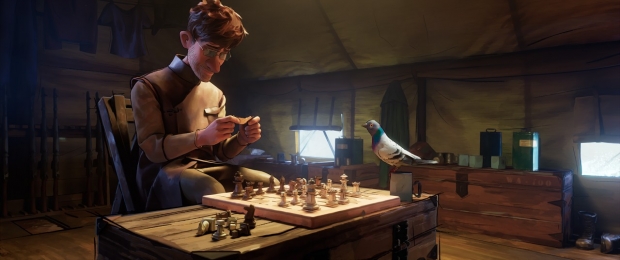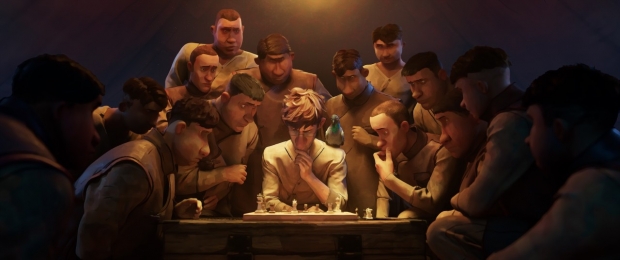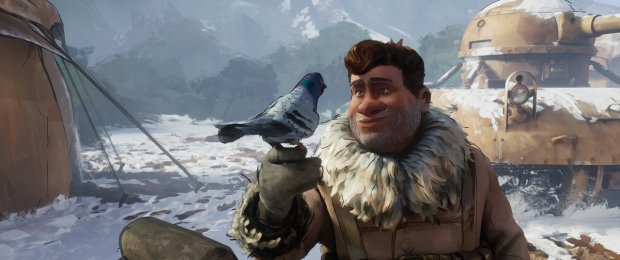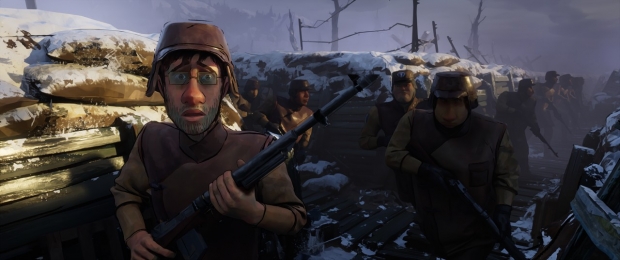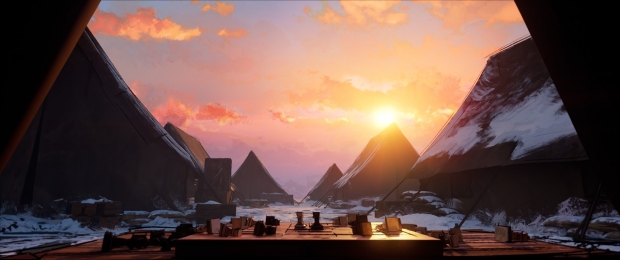Dave Mullins and Brad Booker’s Oscar-shortlisted animated short, inspired by John Lennon and Yoko Ono’s 1971 song, ‘Happy X-Mas (War is Over), and animated in Unreal Engine at Wētā FX, showcases a game of chess, set on a battlefield, with a carrier pigeon delivering instructions on next moves - on the board and in the trenches - leading to a forgone conclusion: there are no winners in war.
16 years into the highly controversial Vietnam War, The Beatles’ John Lennon and his artist/activist wife Yoko Ono released “Happy X-Mas (War Is Over)” as a festive but fervent protest against the Vietnam War. 52 years later, the famed couple’s son, Sean Ono Lennon, assembled a team of talented storytellers and animators to create an anti-war short film working from his parents’ song, as overseas wars like those in Gaza and Ukraine continue to produce unspeakable horrors on humanity.
Nominated for an Annie Award in Best Short Subject and Shortlisted for Oscar consideration in Best Animated Short Film, War Is Over is set in an alternate World War I reality: two soldiers on opposite sides of the conflict play a joyful game of chess, using a heroic carrier pigeon to deliver both war strategies and chess moves over the battlefield as the fighting escalates. As the game and the war build to a climactic final move, one thing is for certain: there are no winners in war.
Check out the trailer here:
The 12-minute short, available to watch on The Animation Showcase, is written and directed by 20-year Pixar alum and Oscar-nominee, Dave Mullins and produced by Golden Globe-nominee Brad Booker, co-founder and founder, respectively, of Electroleague, a real-time animation company based in Los Angeles. Sean and Yoko serve as Executive Producers while Peter Jackson’s Wētā FX produced the animation using Epic Games’ Unreal Engine. The score was composed by 15-time Oscar-nominated, Thomas Newman.
Oscar Shortlist voting ends today, and before casting the final vote, check out our interview with Mullins and Booker as they discuss creating an anti-war film while two current wars continue to escalate, the importance of including soldiers in the conversation to promote peace, and using gaming software to create a 3DCG film that looks hand-drawn.
Victoria Davis: So, I know that last month was the 52nd anniversary of the song’s release, but how did this project initially come to be? Were you approached by Yoko and Sean, or was this an idea that originated with you two?
Dave Mullins: It’s funny. A friend of mine from Pixar, where I worked for like 20 years, called me one day and said ‘Hey, I'm friends with Sean Lennon and Sean’s been wanting to make a music video for his parents’ song and he's met with a bunch of people, and it hasn't really worked out. Would you like to meet him?’ Not nervous at all, I said, ‘Yeah. That would be amazing.’ That was in the summer of 2021, and I went into this thinking we were going to be making a music video. But Sean and I started talking and I realized, ‘Oh, you want to make a film!’
So, we started brainstorming ideas around this anti-war narrative his parents put out in this song, trying to figure out a way we could come up with a story that was about two sides of a conflict, two soldiers, forced by political means to want to kill each other, who would be able to connect and not know they connected.
VD: And the viewers themselves aren’t totally sure if these are two opposing soldiers or soldiers on the same side who are just stationed in different locations. But, as you watch the film, the smoke lifts, in some cases literally, and the plot begins to reveal itself more clearly.
DM: Yeah, and that was intentional, too. When we landed on the carrier pigeon and the game of chess being key players in this story, we knew we had to set this in a World War I alternative environment. But we didn't want to distinguish one side as German or the other side as English or whatever. We want to say, “This is everywhere.” So, the uniforms, the weapons, the tanks, everything is our own design. We also worked with Jack Whittaker on sound design to pull war sounds from every war since World War I, all the way up to today. We had trench guns, Black Hawk helicopters, and tried to misdirect a little bit to make the viewers be like, “What war is this?”
We did distinguish the two sides, but it’s subtle. On one soldier's side, everything on his uniform, even his chess set, is angular with a hard corner. On the other soldier's side, everything is very round. It’s that type of subtlety we were trying to pour into the film so that [you have a], “Holy shit,” moment when these guys eventually have to go after each other.
Brad Booker: I think Dave very cleverly disarms people with the fact that we're playing this innocent chess game and then, before you realize it, the chess game is actually the metaphor for war. It's just like how you think you’re listening to an innocent Christmas song, but it’s an anti-war message of peace.
If someone from Germany or the UK or wherever was watching this, we didn’t want it to come with a bunch of different baggage. We wanted to completely shed that and make people feel like they could be on either side.
VD: That was a good call, I think. Especially looking at where we’re at now, with two horrific wars across the sea still going on. What were your feelings as you watched these conflicts arise during the course of production on an anti-war film?
DM: I'm staunchly anti-war. And I always have been. I just feel that there are other ways that we can resolve conflicts. The answer to killing babies isn't killing more babies. Having kids myself, this was a very important project for me, and all of us, to be a part of. It spoke strongly to my moral compass. It was also why we wanted to include the pigeon as a key character in the film. We don’t want to give away too much, but it’s a kind of symbol for peace and plays a role in showing the different layers of the film.
VD: I think what is also really interesting about your approach is that you included soldiers in this messaging. A lot of anti-war narratives don't bring soldiers into the conversation. You hear a lot from people who have never been on a battlefield, but you don't see a lot of that heartbreak from the soldiers themselves.
DM: I'm really glad you brought that up. My brother's a veteran and I have a friend I met while running a guild in War of Warcraft – I’m a pretty avid gamer – who was a colonel in the army. I showed my friend the film early enough in the process that we could still make some changes. One of the things that he really responded to was how we show the chain of command, specifically the sergeants, who have to put their men’s lives on the line and, the minute they can reverse those decisions, they’ll do it at all costs. We show how these choices really weigh on them. Other veterans we’ve shown the film responded to that the most, as well.
I feel fortunate that we were trying to be very sensitive to what the soldiers were going through in these situations.
VD: I bet it was helpful seeing those reactions and knowing this film was having an impact on men who had enlisted. Outside of showing this to veteran friends, was there much official consultation between your team and war veterans or people who are well-versed in this stuff?
BB: Any film we ever work on is always heavily researched. In this case, a lot of it came from watching other films and making sure the production designer was working closely with Dave to get the right environment put together because, again, we weren't trying to nail specifically World War I. We were making our own recipe, so to speak, by grabbing pieces here and there. We were mostly influenced by friends and family who had been through this.
DM: We also looked at a lot of historical photographs and used that as a springboard for what we were trying to do.
VD: Short films like this also put a decent amount of responsibility on the viewer, too. If you’re paying attention, you’ll pick up the details and nuances of the images and performances.
DM: We do take people on a journey. We start with the brutality and cruelty of war. Then, as the chess game comes up, we start to breathe humanity back into the film. Then, it just gets ripped apart. It does have a sawtooth sort of pattern to the story.
VD: The more you’re paying attention, the more emotionally wrecked you’ll be. That should entice people if nothing else.
DM: Right. Exactly.
VD: We could go on and on about the symbolism of the narrative, but I do want to dive into the animation design. This was done in Unreal Engine, but there are a lot of personal touches that you guys added to this, like the lines in the faces, the black outlining of characters and the pigeon, and the effects. How did you pull the animation together?
BB: Most of it was done in Unreal. That real-time workflow was kind of the backbone to this. And Wētā, in their wizardry, have all kinds of in-house tools. So, there was some magic added and even we don’t know exactly how it went down. But it was important to all of us, from day one, to make sure we ended up with something on the screen that looked like it was created by a human hand, an artist's hand. It's easy when you're using tools like that to approximate human motion perfectly, but we use what we call “layout-meets-rough-animation-blocking,” so Wētā can go in and animate over the top of that blocking and breathe life into everything.
DM: The thing that's great about that process, too, is that we have a pretty big battle scene. And it's hard enough to put that many soldiers on screen. But we can’t have our animators spending all their time on that. So, this is a perfect use of performance capture, where we can block in lots of people fighting and let the animators focus on the main storytelling performances on screen.
We had to figure out affordable ways to be clever and get our stories on screen as quickly as possible. And that's why the real-time pipelines appealed to us.
VD: It’s also nice to see such a detail-oriented piece of animation join the pantheon of stories that prove Unreal is more than a gaming engine, and that not all films that come out of Unreal will look like a video game.
BB: When Epic started to see some of the early scenes come out, they were literally like, “You guys did this in our game engine?” After that, they got behind the film in a big way. And it helped make it what it is now. Our tagline at ElectroLeague is “filmmaking at the speed of thought,” because these tools really do allow the filmmaker to work as quickly as they can think.
DM: At Pixar, we were all complaining for years, asking ourselves, “If I can play this game at 60 frames a second with all the lighting and shadows and all that, why can’t I get this in a top-of-the-line animation software? When are animation tools going to catch up to video games?” And here we are.
VD: My last question, steering the ship back to the narrative, is how would you convince someone who’s not anti-war to check out this film?
DM: I'm not sure that I understand their mindset. But this story is human at its core, and you can apply it to things like your own relationships. I was on a flight the other day, and I sat down with somebody who had different political views than me. We talked very honestly for an hour and 20 minutes on the plane. I think it made some people uncomfortable around us, but we had an incredible conversation and she hugged me three times by the end of it. Labels are bullshit. We are way more alike than we’ve been told. You may not be anti-war, but you’re probably still pro-person. You probably love your family and the people around you. So, look at the movie through those eyes, and just think about the people you love.
